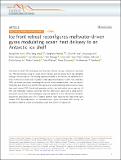Ice front retreat reconfigures meltwater-driven gyres modulating ocean heat delivery to an Antarctic ice shelf
Abstract
Pine Island Ice Shelf (PIIS) buttresses the Pine Island Glacier, the key contributor to sea-level rise. PIIS has thinned owing to ocean-driven melting, and its calving front has retreated, leading to buttressing loss. PIIS melting depends primarily on the thermocline variability in its front. Furthermore, local ocean circulation shifts adjust heat transport within Pine Island Bay (PIB), yet oceanic processes underlying the ice front retreat remain unclear. Here, we report a PIB double-gyre that moves with the PIIS calving front and hypothesise that it controls ocean heat input towards PIIS. Glacial melt generates cyclonic and anticyclonic gyres near and off PIIS, and meltwater outflows converge into the anticyclonic gyre with a deep-convex-downward thermocline. The double-gyre migrated eastward as the calving front retreated, placing the anticyclonic gyre over a shallow seafloor ridge, reducing the ocean heat input towards PIIS. Reconfigurations of meltwater-driven gyres associated with moving ice boundaries might be crucial in modulating ocean heat delivery to glacial ice.
Citation
Yoon , S-T , Lee , W S , Nam , S H , Lee , C-K , Yun , S , Heywood , K , Boehme , L , Zheng , Y , Lee , I , Choi , Y , Jenkins , A , Jin , E , Larter , R , Wellner , J , Dutrieux , P & Bradley , A 2022 , ' Ice front retreat reconfigures meltwater-driven gyres modulating ocean heat delivery to an Antarctic ice shelf ' , Nature Communications , vol. 13 , 306 . https://doi.org/10.1038/s41467-022-27968-8
Publication
Nature Communications
Status
Peer reviewed
ISSN
2041-1723Type
Journal article
Description
This study was sponsored by a research grant from the Korean Ministry of Oceans and Fisheries (KIMST20190361; PM21020) and supported by the National Science Foundation and Natural Environment Research Council (NERC: Grants NE/S006419/1 and NE/S006591/1) for the TARSAN and the THOR projects, components of the International Thwaites Glacier Collaboration (ITGC). ITGC Contribution No. ITGC-061.Collections
Items in the St Andrews Research Repository are protected by copyright, with all rights reserved, unless otherwise indicated.

